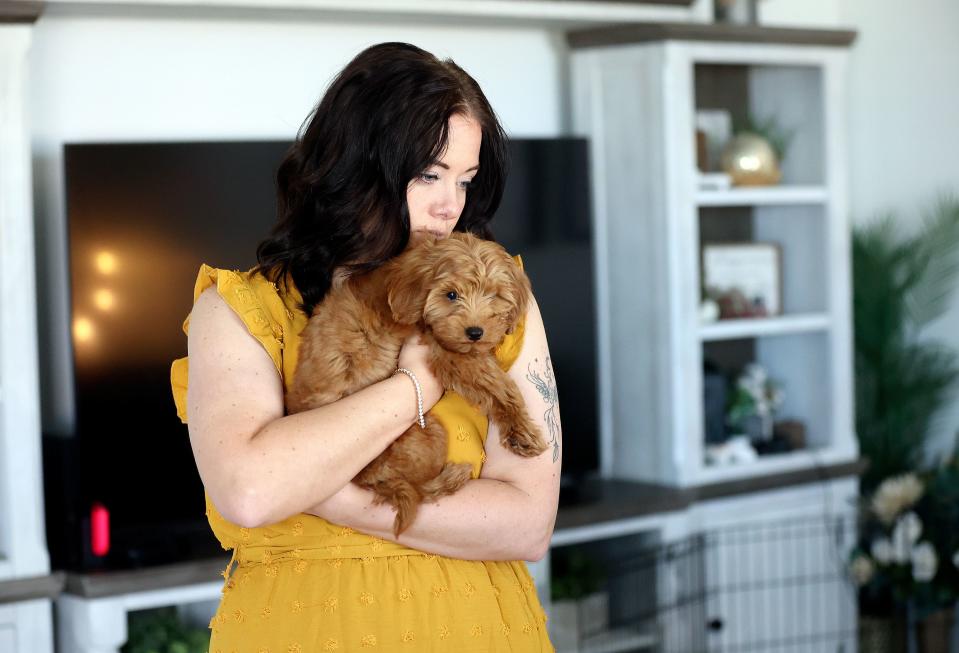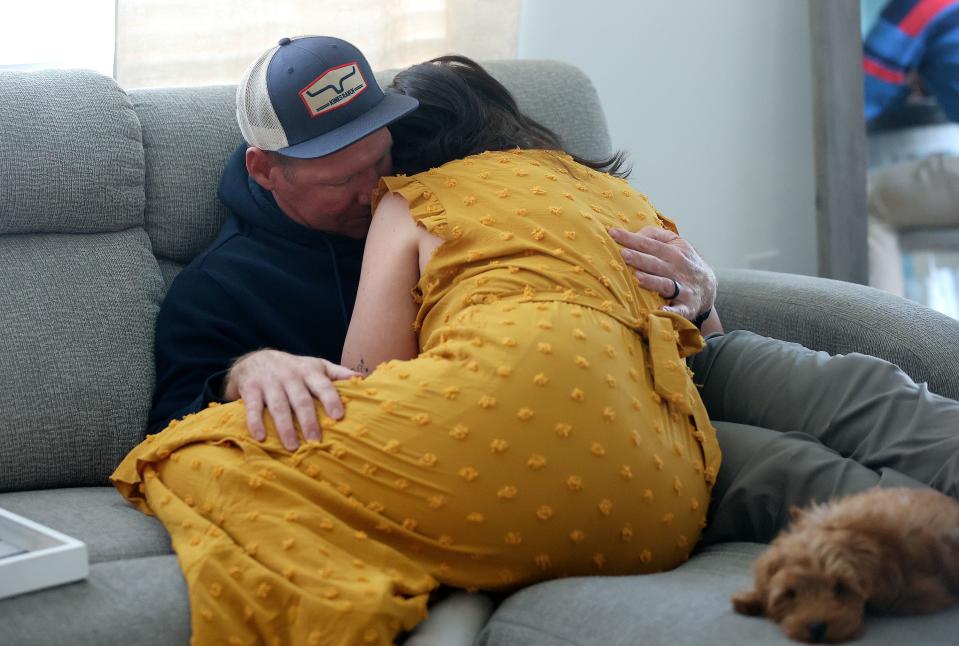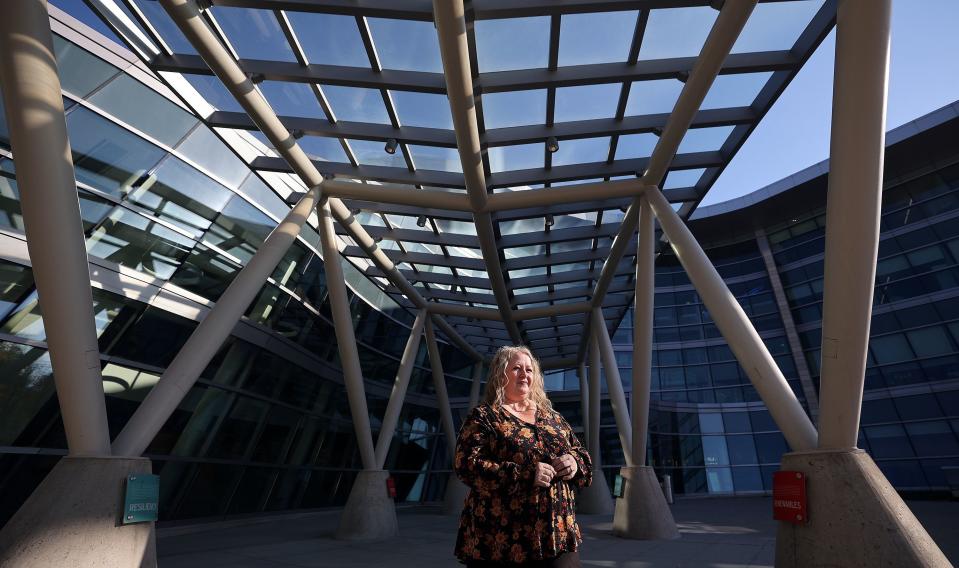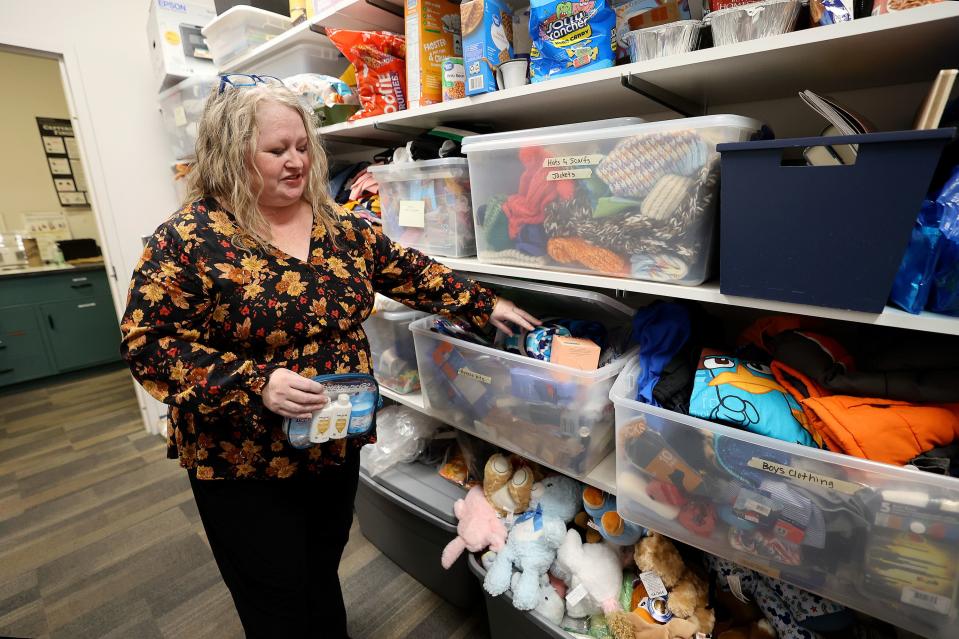Lyndsey’s journey: A story of domestic violence that, unfortunately, millions will relate to

Editor’s note: This is part of a three-story package on domestic violence issues in Utah following months of reporting by the Deseret News and KSL NewsRadio. The package includes stories about those involved in the crisis, a dive into the numbers in the state and the nation and possible solutions state leaders are considering.
At first, it was controlling behavior. The years passed, and it morphed into threats, verbal abuse and manipulation. She was hardly allowed to leave home, and he knew just about every text she sent, every call she made and every dollar she spent. Ten years into their marriage, he started hitting her. She said one night she thought he was going to kill her.
It’s a common story for millions of women. According to the National Coalition Against Domestic Violence, 1 in 3 U.S. women will experience some kind of physical violence from an intimate partner in their life.
But this isn’t a fictional anecdote. This is the story of Lyndsey, a Utah mother and survivor of domestic violence who endured abuse over more than a decade from her then husband. Lyndsey’s journey offers a disturbing yet important window into a cycle of abuse that for many will sound all too familiar.
Lyndsey describes herself as a “bit of a loner” in high school. She didn’t have a lot of friends, and neither did the man she would later marry. They bonded over their independence, and started dating when she was 16 years old.
Her parents didn’t approve of the relationship, so as soon as she turned 18 years old, she moved in with him. She didn’t have career aspirations and she didn’t want to move out of Utah, or even her county. “I wanted to be a mom,” Lyndsey says from the living room of her home in the Utah County suburbs. “A really, really good mom. It was easy to take advantage of that.”
Lyndsey has told her story publicly before. The Deseret News has chosen not to publish Lyndsey’s last name.
In 2006, 19-year-old Lyndsey got married. She said she knew she was unhappy even then, but felt like she didn’t have a choice. “In that moment, I felt like I was living my best life,” she said. The couple had their first child in 2007. Two more kids would follow in the coming years.
But there were red flags. She says he would push a lifestyle that she didn’t believe in. He became increasingly controlling and emotionally abusive. Now, with almost 20 years of hindsight, the red flags are easier to spot — but it remains difficult to describe.
“Even now, people ask, ‘What did he do?’ I don’t really know how to put it into words,” she said.

That’s a common refrain from survivors of domestic violence, some of whom don’t know they are being abused. Lyndsey says for years she was conditioned to feel like this was a normal relationship. She was subjected to jealousy, isolation and financial control, common themes of other cases.
“Probably 80% of domestic violence cases are never even reported, because a lot of victims just assume that’s part of being in a relationship,” said Greg Skordas, KSL legal analyst and defense attorney. In his 40-plus year career, he’s had a domestic violence case come into his office almost every week.
A common component in these cases is destruction of property, like breaking a cellphone or preventing someone from leaving the house — acts indicative of controlling, manipulative behavior.
“It’s intimidation. In order to get somebody to comply with what you want, you don’t have to use violence every time,” said Martha Burkett Fallis, a founding member of the Amethyst Center For Healing, a Salt Lake-based nonprofit that provides counseling for people who have experienced or perpetrated domestic violence.
Related
Each day, Lyndsey says she would lay his clothes on the bed and pack his lunch. He made her feel like that’s all life was, she says. “All I was was his children’s mother. I wasn’t even my own human.”
If she slipped up, he would get angry. Lyndsey says holes started appearing in the drywall of their Utah County home. “I hit the wall instead of hitting mom,” she remembers him telling their kids. He got more and more physical when disciplining the children; his controlling behavior intensified, and soon Lyndsey was hardly allowed to leave the house. She says he knew about every text she sent, every call she made, every website she visited and every dollar she spent.
Through it all, Lyndsey never thought about leaving.
“I didn’t really feel like I had a choice. On my side of the family, divorce isn’t really a thing,” she said.
In 2019, the tension that had been building over the past decade exploded. She returned home from work to an empty house, no idea where her kids were. Worried, anxious and overwhelmed, she tried to contact him.
He finally returned home, angry. She said he took one of his guns, held it to his head and told her: “If you really feel I do nothing as a husband or a father, then I will just pull the trigger.”
“No, that’s not what I think,” she said. He dropped the gun, and she collapsed, crying. He picked her up by the hair and yelled at her, calling her selfish. As she went to sit on the bed, he swung, hitting the side of her head. “Why won’t you let me love you!?” she said he yelled. He filmed much of the incident on his phone.
Lyndsey was in shock. She locked herself in the bathroom.
Then, just minutes later, he left. Lyndsey grabbed her clothes, still damp from the drink she spilled when he hit her, and frantically told her kids to pack their bags. They ran out the back door, across the street and into the neighbor’s yard. Her mother came and picked them up at about 10:30 p.m. “I just need some time,” she texted him.
Two days later, he showed up at her parent’s house. “If you don’t come out, I’m going to call the police,” he told her, accusing her of not letting their kids go to school.
Spanish Fork police responded. Each told their side of the story. “She’s lying, I have a video,” he told officers. He showed them, and was arrested. He spent the weekend in jail and Lyndsey stayed at her parent’s for about six weeks. He’s had this big wakeup call, she remembers thinking.

“It definitely wasn’t that,” she said.
As far as domestic violence calls go, this was a relatively straightforward one for police — officers respond, the perpetrator shows them an incriminating video, and is arrested with no protest from the victim. It’s often far more complex.
“Imagine these people on their wedding day, or the day that they moved in with each other. They did that because there was a lot they saw in that other person that was worthwhile. And they wanted to spend time with them, they wanted to be married to them, they wanted to have a family with them. And so there’s a lot more at stake,” said Sgt. Spencer Cannon with the Utah County Sheriff’s Department. “... They may have been beaten up by this person, but they could still very much be in love with them.”
During Cannon’s 30-year tenure with the department, he’s worked in the jail, on patrol, as a detective and now as a public information officer. He says domestic violence is one of the few crimes that can impact every level of society — blue collar or white collar, educated or uneducated, addicted or sober.
Cannon responded to calls where a woman told 911 dispatchers she was being beaten up, but then decided not to speak to responding officers; where credible witnesses report seeing violence, but officers don’t have enough evidence to suggest anything beyond a heated argument; where a husband and wife each claim they were assaulted, forcing officers to determine who the primary aggressor is; where the woman decides not to press charges, only to call police a month later with life-threatening injuries from the same perpetrator.
“Sometimes you leave a scene and think this is going to happen again, and it’s likely going to be worse next time,” he said.
Officers often see the cycle of domestic violence in real time, where a victim will call police, press charges against their significant other, then refuse to cooperate with prosecutors once the case goes to court.
Lyndsey was caught in a similar cycle. Shortly after moving back in with her husband, an attorney reached out asking her to email the city prosecutor on his behalf.
“I sent an email saying that I want my family to work and I wouldn’t support any cases going forward against him,” she said. They dropped the case that day.
But she says the abuse worsened. He pulled their kids out of school, and made Lyndsey home-school them. He took the keys to her car, made her work from home and forbid her from sleeping. She remembers being locked out of the house and spending the night under their car, being pushed down the stairs, and getting into a fight.
It was around the holidays when Lyndsey, for the first time, thought he was going to kill her. She describes it as “an all-day event.” He knocked her unconscious, hit her “15-20 times with a closed fist,” head butted her and smashed her phone.
Much of this is documented in witness testimony and a probable cause statement from police who responded six days later, after Lyndsey fled to a friend’s house. She urged Lyndsey to call the police, and they arrested her now ex-husband in January 2021. He was charged with assault, criminal mischief and three counts of commission of domestic violence in front of a child. Each count was a class B misdemeanor.
As the case worked its way through the system, Lyndsey was put in touch with a victim’s advocate in Utah County to help her navigate the mountain of logistics.
If a survivor calls a domestic violence hotline and is admitted into a shelter, they often have a month to find a new job, move into a new apartment, buy a car or figure out reliable transportation, overcome child care, attend court hearings, and talk to attorneys, prosecutors and more. All while dealing with some kind of trauma — mental and physical — from the abuse.

“They’re probably not sleeping, their stomach is probably upset. What happens if they have a broken foot and were asking them to travel to all these places?” said Wendy Isom, director of the Salt Lake City Police Victim’s Advocate program. “Even when the system does a good job of providing victim services, it’s overwhelming.”
Isom started working with Salt Lake in 2004 — in that time, she says the victim’s advocate program has blossomed, with more resources available for survivors, and victims rights gaining a stronger legal foothold. “But I still think we have quite a way to go,” she said, describing the “hundreds” of obstacles that may prevent a victim from taking advantage of her services.
There can be a language barrier, or issues with providers who are not culturally competent when working with immigrant or refugee communities; victims might not have a car, a phone or internet; mental illness or addiction is a roadblock to navigating a complex legal system; shelters are often full, and if they aren’t, they might have limits on admitting pets or length of stay; attorneys are expensive, and free legal services aren’t always available or adequate; many of the aforementioned resources lack funding.
For Lyndsey, bringing her case to trial meant the trauma of the past decade was boiled down into legal jargon, debated in court, and subjected to flippant remarks from attorneys and the judge. She describes it as her life becoming someone’s folder.
“I can see why people on this end give up. It’s a constant battle of me being OK, seeing people say I’m crazy … and I have to be OK with just letting that be out there,” she said.
It took more than a year for the case to go to trial. When it did, Lyndsey had to fight the narrative that she made it all up. She had to testify in person, and as a prosecutor instructed her, the single day that prompted a police response was the only day she could talk about. The court didn’t care about other incidents.
“It’s really traumatizing,” says Sen. Stephanie Pitcher, D-Millcreek. A former prosecutor for Davis County, Pitcher has seen a number of domestic violence cases come across her desk and during her time as a lawmaker, has run a number of bills intended to simplify a victim’s experience with the legal system.
“When you think of all of the different types of criminal cases that are filed in the system, domestic violence cases are very unique in the way that the case impacts the victim. You could have a victim of a vehicle burglary or credit card fraud, and you can bring those victims into court, and the experience for them is going to be different than a domestic violence victim. So as a matter of good public policy, we ought to find a way to give prosecutors the tools they need,” she said.
Pitcher has sponsored a bill to allowing prosecutors or defense attorneys to move a domestic violence case from Justice Court to District Court, so victims only have to endure one trial. She’s also taken on bail reform, asking judges to consider risk, rather than wealth, during the pre-trial stage.
“The question that judges now had to ask after bail reform was, how do I measure and understand this person’s risk? And what conditions can I put in place to mitigate that risk so they can either be safely released or held?” she said.
Lyndsey’s former husband was found guilty, according to court documents, and was sentenced to 30 days in jail and 30 days under house arrest. They divorced, and she was given full custody of their kids. He was also listed as a category II restricted person, making it a felony to purchase, transfer or possess a firearm.
“The punishment he was given wasn’t a punishment. What do you learn from 30 days of staying at home when you’re already staying at home?” Lyndsey said.
Lyndsey claims he had at least five guns registered in his name at the time of his arrest.
Utah is one of 32 states where people guilty of a charge involving domestic violence, whether it’s a felony or misdemeanor, are deemed restricted and cannot own or purchase a firearm. And perpetrators with protective orders filed against them are required to sign a form acknowledging the law.
But Utah law does not require perpetrators to surrender their weapons.
“We have to have relatively solid information before we can go in and do something,” said Cannon. That could include a credible tip of a restricted person going to a shooting range, a picture of them on social media with a firearm, or a witness seeing them make a purchase at a gun show.
What isn’t enough evidence, Cannon said, are reports of a perpetrator owning a firearm before they became restricted.
“That wouldn’t be enough to go and look in that person’s house,” Cannon said.
Slowly, Lyndsey’s life began to return to normal. She started sleeping again, found steady employment and regained a sense of independence. Basic tasks like going online, sending texts and speaking freely on the phone no longer felt impossible. She met a man, Andrew, at her new job. During the holidays, he recruited Lyndsey’s daughter to hide an engagement ring between the presents underneath their Christmas tree.
With her three children watching, Lyndsey gave him an emphatic yes. “It was perfect.”
If you or someone you know is experiencing domestic or dating violence, resources are available. If there is an immediate danger, call 911. The Utah Domestic Violence Coalition number is 1-800-897-5465. The National Domestic Violence Hotline is 1-800-799-7233.


